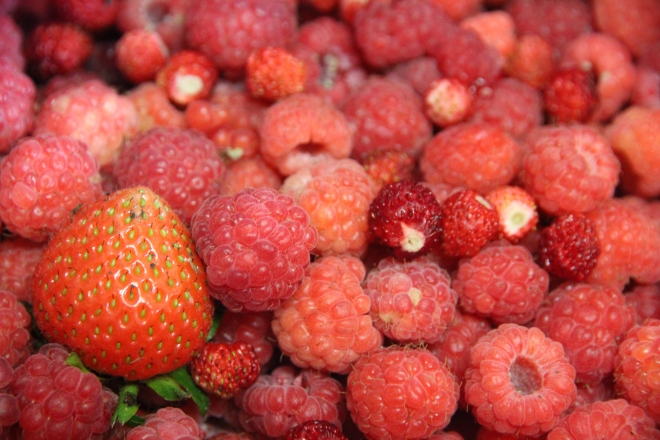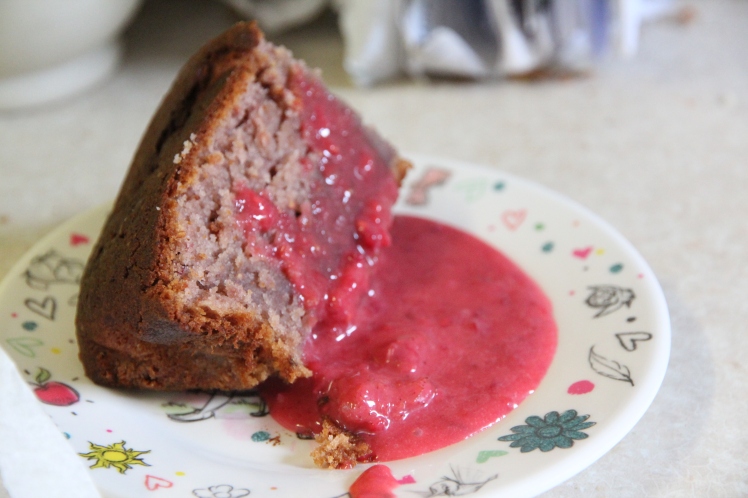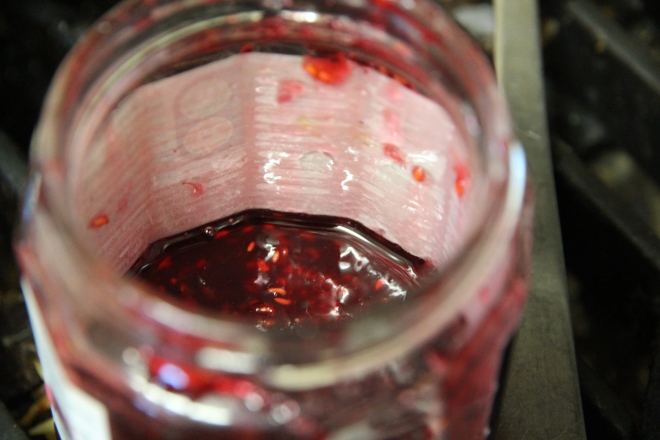
Raspberries, Rubus, are of the rose family. They are a widely commercial fruit crop, grown in all temperate regions across the world. Many of the modern commercial raspberries are hybrids of Rubus ideaus and Rubus strigosus. Recent breeding has resulted in thornless cultivators that stand upright strongly without the need of staking.
They are believed to have originated from Eastern Asia. Archeological evidence has shown us that Palaeolithic cave dwellers consumed raspberries and that the berries have been part of the human diet for centuries although the canes were not cultivated until about the 4th century. Raspberries were associated with fertility and in Greek mythology, raspberries were white until Zeus’ nursemaid, Ida, pricked her finger on a thorn and stained the berries red. Rubus ideaus translates as ‘bramble bush of Ida’. During the 13th century, the juice of the berries was used to stain artwork red.
The black raspberry is Rubus occidentalis with a distinctive flavour. Purple raspberries are hybrids of red and black types. They can be found wild in a few places, such as Vermont. A blue raspberry is a cultivator called ‘Columbian’, a hybrid of a purple raspberry, black and red. There are about 200 different species of raspberries in total. Raspberries have also been crossed to create the wonderful boysenberry and before that, the loganberry. My gran gave us a loganberry last year and we purchased a boysenberry plant this year after discovering ‘Bunny Loves: Boysenberry Jam’ when on holiday in Dorset a couple of years ago.

Raspberries are grown for their fresh fruit market and their ease at being frozen, pureed, dried and made into wonderful conserves. Traditionally they were a midsummer crop but due to cultivation and travel, they can be obtained all year round. We often start picking our own around June until late autumn, often coinciding with the frosts.
Raspberries need ample sun and water and thrive best in a soil pH 6-7.
Raspberries are a rich source of vitamin C, 26g per 100g serving, and dietary fibre, 6% total weight and one of the highest recorded in whole foods.
Raspberry leaves can be dried and used for a flavoured tea that can soothe the digestive system and ease cramps. There was a time when the leaves of the raspberries were values higher than the berries due to their medicinal uses.
Raspberries have long been associated with herbal remedies. Today, we recognise cancer and heart disease fighting properties within these berries, notably ellagic acid. Raspberry tea is recommended to women after childbirth to ease pain, a mouthwash can be made including raspberries that prevent gum bleeding and the tannins in dried raspberry leaves can soothe sunburns and other minor burns. Raspberries also contain antimicrobial properties that can inhibit Candida albicans, a trigger for IBS. Like strawberries and other dark berries, raspberries fight macular degeneration and promote healthy eyesight.
The biggest threat to your raspberry fruits will be birds. If you have a severe issue, netting or bird scarers are the only defence. We fortunately have so many, our birds seem to run out of steam and target the strawberries, blackcurrants and redcurrant bushes more often. As far as diseases are concerned, raspberries can develop severe root rot from an overly-wet ground that can destroy the plant itself. You want to make sure the raspberry is well-watered when it is fruiting but is planted in well-drained soil to prevent this tragedy from happening – otherwise you will be forced to get rid of your plants and start again and Verticillium wilt can stay in the ground for years at a time.

Raspberries are usually sold as dormant bare-rooted canes. Plant them 45 cm or so apart in well-fed soil in rich, rotted, organic matter. Leave 2 metres between rows of summer-fruiting varieties and 1 metre for winter-fruiting varieties. Raspberries are shallow rooting so resist planting them too deeply. Summer raspberries produce fruit on canes that grew the year before so do not expect any produce the first summer. Each cane fruits only once so remove the old canes after harvest is over to leave room for new ones to grow. If the canes flop over, tie them to bamboo sticks or some other prop to hold them up and make them easier to pick (we finally did that this year and it is making it a lot easier for us, and regrettably most likely the birds too, when harvesting them). Autumn raspberries ripen their fruit on the current year’s canes so they will not produce anymore the next year. Raspberries are very good at spreading suckers and creating new plants, hence why we have so many which we are very pleased about! If you do not want to extend your crop, pull up the baby plants as the sprout. It is recommended to replace your raspberry plants at around ten years. If you are considering growing one in a container, autumn varieties are smaller and are more suitable for you.

Summer raspberries should be ready for picking from mid-June to August and autumn varieties will ripen from August to October. Keep an eye on them as they ripen and mould quickly. Keep picking as it encourages more growth from the plant. They are delicious eaten fresh but we almost always have a glut which I am happy about as I freeze them and make them into our ever-popular raspberry jam. Otherwise, I am happy to use frozen raspberries in baking, such as cakes.
Fresh raspberries can be eaten on their own, with yoghurt or ice cream, whipped in cream to make a fool, baked in a crumble, tart or pie, made into a fruit leather, bottled for preserving or juiced with apples or blackberries for a drink.
I start the raspberry recipe collection with my latest discovery, Nigella Lawson’s lemon and raspberry muffins (‘How to be a Domestic Goddess’).
Lemon and raspberries pair quite nicely together. I would try replacing the raspberries with blueberries when they are in season, or bilberries if there are any ready for picking now. Happy baking!

Nigella’s Lemon-Raspberry Muffins
(Serves 12)
– 60g butter – 200g plain flour – 2 teaspoons baking powder – ½ teaspoon bicarbonate of soda – 150g caster sugar – ¼ teaspoon salt (omit if using salted butter) – Juice & finely grated zest of 1 lemon – Approximately 120ml milk – 1 large egg – 150g raspberries
1. Preheat the oven to 200C and line a muffin-tray with 12 large paper cases.
2. Melt the butter in the microwave or in a pan over a medium flame. Set aside.
3. In a large bowl, stir together the flour, baking powder, bicarb, sugar, salt (if using it) and the lemon zest, finely grated.
4. In a measuring jug, pour in the lemon juice, then enough milk to reach the 200ml mark. Beat in the egg and melted butter.
5. Pour the wet ingredients into the bowl of dry ingredients and stir briefly , until just combined. Fold in the raspberries gently.
6.Spoon the mixture into the muffin cases and bake in the centre of the oven for about 25 minutes. When cooked, the tops should spring back to your touch and be golden coloured. Leave in the tray for about ten minutes before turning them out onto a wire rack to cool completely. Store in an airtight container.






































